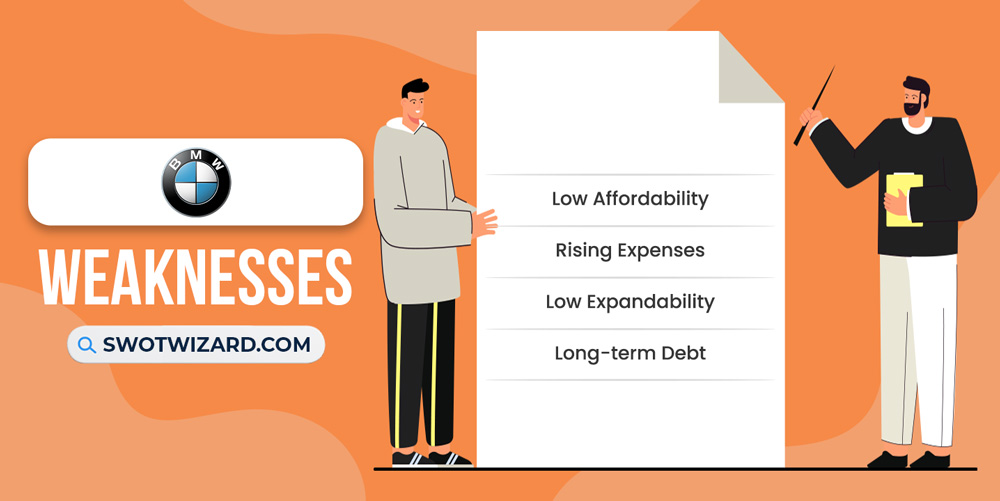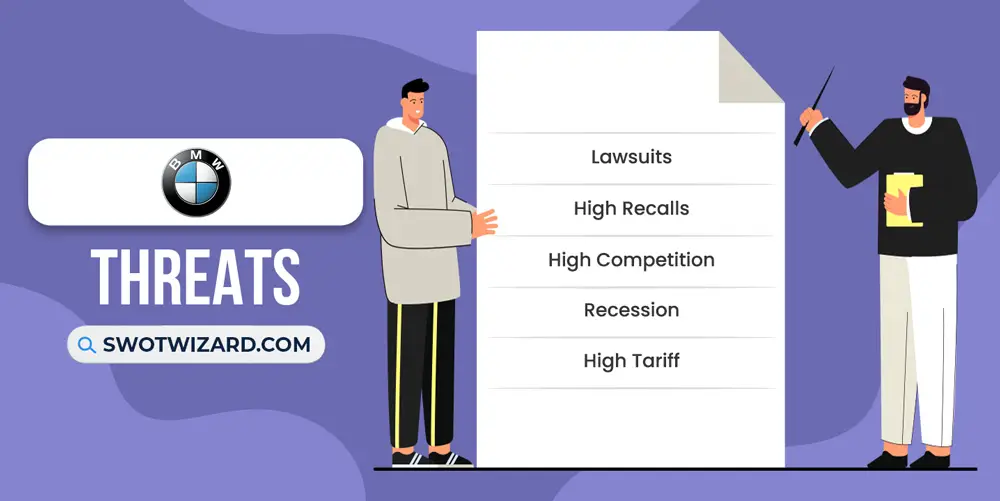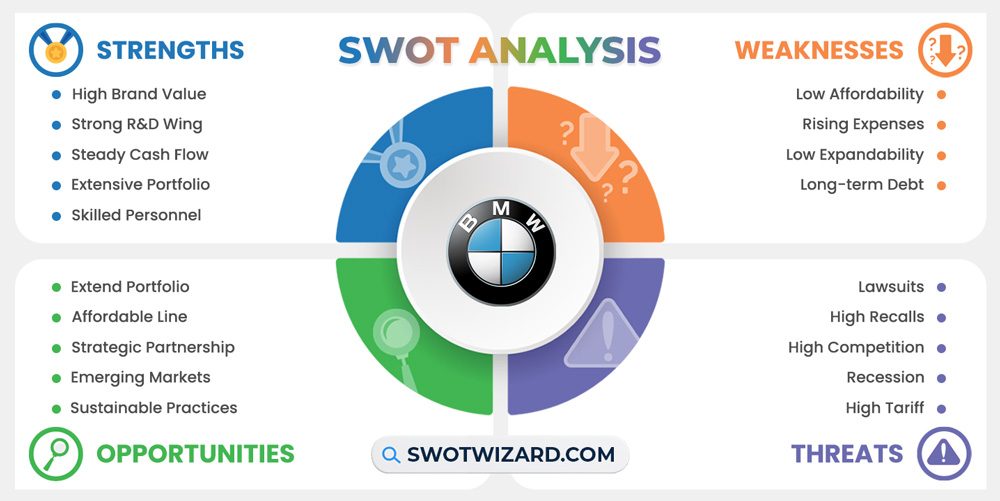When we hear the name “BMW” or think about it, all we can think of is its luxury cars and a blue and white logo with a black border. No matter which part of the world you’re from, when someone sees a BMW car, they want to have one at least once in their lifetime.
As prestigious and wealthy as that might sound, it took a long path to reach today’s place, the company, with many strengths, opportunities, weaknesses, and threats to overcome; we will get to know more in this BMW swot analysis.
BMW: Company Overview
| Company | Bayerische Motoren Werke AG (BMW) |
| Industry | Automotive |
| Founded | 7 March, 1916 |
| Founders | Camillo Castiglioni, Franz Josef Popp, Karl Rapp |
| CEO | Oliver Zipse |
| Headquarter | Munich, Germany |
| No. of Employees | 118,909+ |
| Annual Revenue | €111.239 billion (FY 2021) |
| Website | bmw.com |
Even though we know BMW as a luxury vehicle and motorcycle manufacturer, the company was founded as a manufacturer of aircraft engines in 1916. Then the company expanded into motorcycle production in the 1920s and began producing cars in the 1930s. After World War II, BMW resumed production of motorcycles and cars and has since grown into a leading luxury automaker.
As of December 2022, BMW has over 149,475 employees and operates in more than 140 countries worldwide. The company’s headquarters are in Munich, Germany, and it has additional production facilities in other countries, including the United States, China, and South Africa. In 2022, BMW reported total revenues of €142.6 B.
The company is focused on innovation and sustainability, investing heavily in research and development of new technologies such as electric and autonomous vehicles.
Product & Services of BMW
Cars | Motorcycles | Financial Services
BMW Competitors
Porsche | Audi | Mercedes-Benz | Toyota | Honda | Ford | Volkswagen | General Motors
Did You Know?
Even though we have known about Electric cars in the last few years, the history goes back to 1972 when BMW produced its first electric car, the BMW 1602 Electric, which had a range of up to 37 miles.
Strengths – BMW SWOT Analysis

High Brand Value: BMW is one of the renowned brands with a high brand value worldwide. In 2022, BMW was ranked the 76th most valuable brand globally, worth $27.6 B. BMW’s success is attributed to its iconic designs, cutting-edge technology, and exceptional performance. In 2022, BMW sold 2.4 M vehicles worldwide, indicating its popularity and strong market presence.
Strong R&D Wing: With more opportunities to grab and stay ahead of the market, BMW consistently spends a significant amount on its R&D unit. In 2022 alone, they spent around €6.6 B for their Neue Klasse program. Besides, their total R&D spending has increased by 5.2% from the previous year for inventing new electric cars.
Steady Cash Flow: The company has maintained a steady cash flow with solid financial ratios. In 2022, BMW’s revenue was €142.6 B. However, BMW’s net income margin was 13.88%, and its return on equity was 13.04%, indicating efficient use of its assets to generate profits. They installed a new CFO to help them overcome the other financial issues to maintain a healthy cash flow.
Extensive Portfolio: From luxury cars to motorcycles, BMW has a comprehensive portfolio of vehicles. Under its three brands (BMW, Mini, and Rolls-Royce), the company sold 2.4M cars in 2022. The BMW brand offers various models, including sedans, SUVs, sports cars, and electric vehicles, catering to multiple customer segments and maintaining a solid market presence.
Skilled Personnel: The company highly emphasizes employee training and development, with its BMW Group Academy offering various programs for its employees. In 2022, the company invested €1.3 B in employee training for its 149,475 employees worldwide, reflecting its commitment to fostering a skilled workforce.
Successful Strategies: Including tons of their successful strategies, the company is now focusing on its “Sustainability through Innovation 2022”.With constant investments and a focus on renewable energy and sustainable manufacturing processes, the company also aims to reduce its carbon footprint by 80% by 2030, which will help it maintain a competitive edge in the industry.
Weaknesses – BMW SWOT Analysis

Low Affordability: BMW comes with luxury features, but at high prices, making them less affordable for the average consumer. The average price of a BMW vehicle in the United States is around $43,800 to $58,400. The pricing strategy targets affluent customers willing to pay a premium for luxury vehicles, but may make BMW less accessible to budget-conscious consumers.
Rising Expenses: Due to higher research and development expenses, marketing costs, and investments in electrification and digitalization, BMW has been experiencing increasing expenses in recent years. The company’s total operating expenses amounted to $33.735 B, an increase of 16.35% from the previous year in 2022.
Low Expandability: Limited market share may make it challenging for the companies to expand their customer base, especially in more price-sensitive markets. In this case, BMW’s expandability is limited by its focus on high-end luxury vehicles. The global market share of new car sales suffered a -4.8% decrease in 2022, ranking it the world’s tenth-largest automaker.
Long-term Debt: The company’s strong financial position and consistent cash flow generation support its ability to service its debt obligations. But, its balance sheet has a significant amount of long-term debt. As of September 30, 2022, the company’s long-term debt amounted to $59.981 B.
Opportunities – BMW SWOT Analysis

Extend Portfolio: BMW has the potential to extend its portfolio to cater to a broader market. In recent years, the company launched the iX and i4 electric vehicles, showcasing its commitment to sustainability and innovation. BMW has also announced plans to introduce 25 electrified models by 2023, highlighting its ambition to expand its product range.
Affordable Line: While BMW has a reputation for producing high-end luxury vehicles, the company has the potential to introduce an affordable line of cars. The global market share of budget cars increased by 5.4% from 2012 to 2022. By offering more affordable models, BMW can tap into this growing market and attract a broader customer base.
Strategic Partnership: Partnerships can help BMW access new markets, technologies, and expertise, driving innovation and growth. A couple of years back, BMW and Daimler partnered to share resources and reduce purchasing and mobility service costs. Besides, in the last year, they have partnered with AirConsole, which can give them better exposure.
Emerging Markets: By expanding the company’s presence in emerging markets, BMW can access a more extensive customer base and increase its market share. As per the data, the global automotive market is projected to grow at a CAGR of 9.2% from 2022 to 2030. Emerging markets such as China and India are expected to drive this growth.
Sustainable Practices: Carbon emissions by the automobile industry have become a massive concern, and by prioritizing sustainability, BMW can attract a growing market of eco-friendly consumers and enhance its brand image as a socially responsible company. Because of that, their goal is to reduce the carbon emissions rate and use 40% of recycled products by 2030.
Threats – BMW SWOT Analysis

Lawsuits: Legal challenges could result in significant financial and reputational damage for the company. As we can see, the company settled a class-action lawsuit in the United States related to alleged defects in its vehicles’ timing chain tensioners for $478 million just three years back. Even in 2023, BMW is facing a lawsuit related to emissions cheating in Germany.
High Recalls: Recalls can increase costs and damage the company’s reputation if they are not addressed promptly and effectively. Due to airbag and brake issues, BMW recalled over 25K vehicles in the United States alone in 2022. Besides, fire risk issues are continuously rising in the new product lines.
High Competition: BMW had a global market share of around 4.78% in 2022, compared to Mercedes-Benz’s 5.04% and Audi’s 3.44%. The company faces tough competition from other established brands and new entrants like Tesla in the luxury car market and product categories.
Recession: The 2008 recession significantly impacted the global automotive market, with a 40% decline in sales and a 45% in employment. As a worldwide 2023 economic downturn can impact consumer spending and confidence, BMW remains at risk from future recessions that could affect its sales and financial performance.
High Tariff: The USA imposed a 25% tariff on imported luxury cars from the European Union five years back. And as a German car manufacturer, this high tariff directly impacted BMW. Besides, in certain countries, BMW faces potential threats from high taxes imposed on imported vehicles.
[Bonus Infographic] SWOT Analysis of BMW

Recommendations for BMW
With a hundred years of experience and history in the industry, BMW is now facing new challenges with time, but there are some opportunities for them too. Here are some potential recommendations for the company.
- Targeting high-growth regions such as Asia-Pacific and Africa to tap into new customer segments and diversify its revenue streams.
- Introducing a more affordable line of vehicles to appeal to price-sensitive consumers could help capture a larger market share.
- Enhancing its sustainability initiatives could meet the growing demand for eco-friendly vehicles.
- The company could proactively address potential legal challenges and mitigate risks through effective compliance programs.
- Strategic partnerships could help the company explore new revenue streams, exposing it to new markets and effective and efficient operational processes.
Frequently Asked Questions (FAQs)
Is BMW a Luxurious Car?
Yes, BMW is a luxurious car.
What is the Nickname of BMW?
The nicknames of BMW are bimmer or beemer or beamer.
Final Words on BMW SWOT Analysis
With a strong brand reputation, extensive portfolio, and successful strategies, BMW is going strong in the market. But, it is facing challenges such as rising expenses and limited expandability. On the other hand, it has opportunities to introduce affordable models, expand to emerging markets, and prioritize sustainable practices. However, BMW must also navigate legal threats and competition from other luxury car manufacturers. BMW’s financial strength and commitment to innovation position it for continued success in the highly competitive automotive industry.
References
- Wikipedia contributors. (n.d.). BMW. Wikipedia.
- Martin, C. (2023, March 9). BMW ups R&D spend on new EV platforms and powertrains. Autocar.
- BMW earnings lag some estimates, names new finance chief. (2023, March 9). Reuters.
- Waldersee, V. (2023b, March 15). BMW cautiously optimistic on 2023, EV targets ahead of schedule. Reuters.
- Murphy, P. (2022, October 11). BMW opens digital upskilling, future technologies training centre at Spartanburg. Automotive Manufacturing Solutions.
- BMW Group Sustainability through Innovation 2022. (2022, September 19). BMW Group.
- John, D. (2020, July 28). BMW plans to have twenty-five electrified models by 2023, including the 5-Series. Drive Tesla.
- Gardner, M. (2022, October 11). New BMW Partnership Brings Video Games To Its Cars From 2023. Forbes.
- Shepardson, D. (2017, February 7). BMW agrees to settle vehicle water damage suit for up to $478 million. Reuters.
- Waldersee, V. (2023a, February 7). BMW emissions challenge unfounded, court rules, NGO to appeal. Reuters.
- Mayorquin, O. (2023, February 27). 107,000 vehicles recalled by Hyundai, Mercedes-Benz and BMW: Check latest car recalls. USA TODAY.
- Almost 50% Expect a Possibility of an Economic Recession in 2023. (2023, March 12). Real Research Media.
- Factbox: German exposure to U.S. tariffs on European car imports. (2019, February 23). Reuters.




